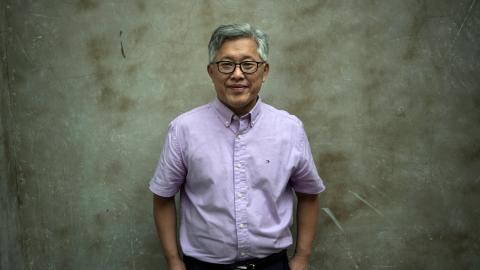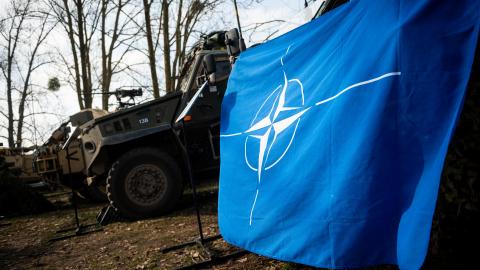Written Testimony
Chairman Risch, Ranking Member Shaheen, distinguished members of the Committee: thank you for the opportunity to testify before you today.
Europe’s Strategic Backdrop
Europe remains of vital importance to the United States. Last year, total U.S. trade in goods and services with Europe exceeded $2 trillion while European foreign direct investment (FDI) in the U.S. stood at $3.5 trillion and U.S. FDI in Europe reached $4 trillion. The Netherlands, host of next week’s North Atlantic Treaty Organization (NATO) Summit, holds the largest FDI position in the United States of any country in the world. At one-third of global gross domestic product (GDP), the transatlantic economy dwarfs that of all other U.S. relationships in the world, including with Asia.
Worryingly, the transatlantic alliance is under threat. Russian President Vladimir Putin remains implacably opposed to the U.S.-European partnership, which he seeks to undermine at every opportunity. In recent months, European intelligence services have issued one warning after another about the prospect of Russian aggression against a NATO member state.
In February, the Danish Defense Intelligence Service forecast that under the right conditions, Russia would be able to begin hostilities with a neighboring state within six months of a ceasefire in Ukraine. The Economist reported last month that a separate Danish intelligence assessment characterized Russian rearmament as having “changed character from reconstruction to an intensified military build-up.” Russia’s reconstitution of its Leningrad Military District, de facto takeover of Belarus, plans to expand its ground forces, and establishment of bases and rail networks along the Russian-Finnish border have all reinforced to Europe the unavoidable truth that Russia’s postwar focus will be on NATO. As Bruno Kahl, the outgoing head of Germany’s Federal Intelligence Agency, stated last week, “We see that NATO’s collective defence promise is to be tested. … We are very sure, and we have intelligence evidence to back this up, that Ukraine is only one step on Russia’s path towards the West.”
A New NATO Bargain: Five for Five
Europe now faces a choice, as NATO Secretary General Mark Rutte put it last week: either invest in defense or “learn to speak Russian.” Europe’s post-Cold War fallback option, to offload deterrence onto the United States, is no longer tenable.
Since returning to the White House, U.S. President Donald Trump has walked a tightrope, exposing allies in Europe to just enough Russian power to engender burden-shifting without going so far as to risk another security crisis on the continent. Thus far, this approach has achieved a high return on investment, most notably by prodding Europe’s economic giant, Germany, into exempting defense spending from its constitutional debt brake. Over time, the upshot could be hundreds of billions of euros in new defense outlays.
Two weeks ago, defense ministers paved the way in Brussels by agreeing to new capability targets that represent, on average, a 30 percent increase over existing goals. To turn promises into reality, NATO should consider supplementing its defense ministerials with a new finance ministerial, comprised of allied ministers of finance, many of whom in parliamentary democracies control their country’s purse strings. As my Hudson Institute colleague, Luke Coffey, has argued, this would prove far more useful than annual leader-level summits, which have proven costly, time-consuming, and often unnecessary bordering on the counterproductive.
To be sure, the same Trumpian style which is pushing Europe toward these increased defense spending targets has also raised questions about America’s staying power. Left unattended, these anxieties may spur allies to engage in hedging by way of so-called European strategic autonomy, with all the attendant downsides such an approach would entail for U.S. defense contractors and America’s leverage against China.
At the NATO Summit, therefore, President Trump should look to convert Europe’s unease into deliverables. Thanks to his leadership, NATO stands on the cusp of an ambitious new investment pledge: 5 percent of GDP for defense, of which 3.5 percent is set aside for hard power while 1.5 percent is to be earmarked for related costs, such as cybersecurity and infrastructure.
At President Trump’s urging and Secretary General Rutte’s behest, NATO should ratify the new 5 percent goal, to be achieved over a five-year time horizon, with tightly defined categories for what constitutes defense spending; in return, President Trump should preempt any moves toward strategic autonomy by reiterating his ironclad commitment to Article V of the Washington Treaty, which commits allies to mutual defense.
Such a “five for five” arrangement would have the additional benefit of challenging the U.S. to make larger investments in our own military going forward. Most importantly, it would force Russia to think twice about any moves against NATO.
U.S. Force Presence
There is no bigger deterrent to Russian aggression in Europe than forward-deployed U.S. forces. Today, the U.S. stations just over 65,000 troops in permanent facilities across Europe, with an additional 20,000 forces rotating through the continent since Russia’s invasion of Ukraine. In total, the number of U.S. servicemembers across Europe remains far below the historical average of the past seventy-five years.
The expectation across the alliance is that the U.S. will downsize its troop presence in Europe. Although U.S. Ambassador to NATO Matt Whitaker has communicated to partners that in-depth consultations will not begin until after next week’s Summit, the status of American forces in Europe will loom over the proceedings.
The preference of our senior military commander is clear. “Since we originally surged forces forward in 2022, we have periodically reviewed for structure both the military and policy level,” General Christopher Cavoli, the outgoing head of EUCOM and SACEUR argued before the House Armed Services Committee in April, “and I have consistently recommended throughout that period to maintain the forces we surged forward, and I would continue to do so now if asked.”
The reasons are myriad. An on-the-ground presence allows U.S. forces to absorb local factors like terrain and weather, deepen interoperability with allies, benefit from the savings of host nation support, and project power around the world. As my Hudson Institute colleague, Dan Kochis, reminds us in a forthcoming paper, the U.S. forces ordered to respond to the attack on the U.S. embassy in Benghazi, Libya on September 11, 2012, were based in Spain at Naval Station Rota.
Most of all, U.S. forces in Europe counteract Russian advantages. Although NATO is a superior fighting force, Russia has local superiority in the eastern flank of the alliance. It can deploy forces opposite NATO countries that lack strategic depth and heavy divisions. Moreover, because NATO is a defensive alliance while Russia is a revisionist power, Putin can decide to initiate hostilities at a time and place of his choosing secure in the knowledge that NATO is highly unlikely to act first.
These factors make it all the more important that NATO maintains forward presence and adequately resources the NATO Force Model’s multi-tiered system of force generation. Ambassador Whitaker has promised “to make sure that there are no security gaps” in Europe. For now, this will require the continued deployment of U.S. strategic enablers, from Intelligence, Surveillance, and Reconnaissance (ISR) assets and Electromagnetic Warfare (EW) capabilities to Strategic Airlift, Ballistic Missile Defenses (BMD), and Command and Control (C2) infrastructure.
Russia’s Hybrid Way of War
To date, Russia has eschewed major war with NATO. Instead, it operates just below the threshold of conventional war by prosecuting a campaign of gray zone attacks that numbers in the dozens, if not hundreds, of incidents. These range from funneling illegal immigrants toward NATO borders to undertaking arson attacks on major public venues. Moscow even reportedly planned the assassination of the CEO of Rheinmetall, Armin Papperger, one of Europe’s largest arms manufacturers, and planted incendiary devices on Western cargo planes, with plans to target airplanes bound for the United States.
Russia’s hybrid war is now discussed at nearly every NATO ministerial, but the alliance’s response remains deliberate bordering on the tepid. This month, the alliance adopted a new hybrid strategy, but it has mostly confined itself to three categories of countermeasures. First, NATO has improved information sharing within the alliance and publicly blamed Russia for its operations. Second, it has sought to drive up the costs of Russia’s actions. In December, for example, Finnish forces boarded the oil tanker Eagle S and took legal steps against it for dragging its anchor across an undersea power cable, an increasingly common occurrence. Third, NATO has pulled together an observation mission in the Baltic Sea. In January, NATO launched Baltic Sentry to patrol and track Russia’s shadow fleet of tankers.
These defensive measures have not deterred Russia. At little cost to itself, Russia has saddled the alliance with huge expenses, like repairing damaged undersea infrastructure. NATO members may need to consider additional countermeasures, like offensive cyber operations, to reestablish deterrence in the realm of hybrid operations. Moreover, some NATO members have begun to explore and define at what threshold a hybrid attack could lead to the invocation of Article V.
Russia’s Alliance System
Russia cannot take on NATO on its own. In fact, it still borrows power from the West today. In 2024, the European Union (EU) saw a rebound in Russian gas imports, even as the European Commission works to end Russian energy imports in the next two years. Similarly, Russia continues to use systems in Ukraine that rely on dual-use technologies sourced from Western commercial markets. As a first step, therefore, the West must redouble its efforts to end its Russian energy imports and block Russian shell companies from circumventing export controls.
More broadly, however, it will have to tighten the noose on Russia’s global partnerships. In the 2019 London Declaration, NATO flagged “China’s growing influence” as a factor for the alliance for the first time. By the time of the Washington Summit last year, NATO expressed “profound concern” for the “coercive policies” of China and its deepening strategic partnership with Russia. Beijing’s vast defense industrial support for the Russian war machine, especially its provision of microelectronics and machine tools, has proven of the utmost significance for Russia in Ukraine. It is an open question if Russia could continue the war in Ukraine without Chinese support.
Iranian drones and North Korean artillery have also allowed Russia to defy expectations and sustain a consistently high operational tempo in Ukraine. Many of Russia’s drones, which now account for more casualties in Ukraine than any other weapon system, are derivates of Iran’s Shaheed family of unmanned aerial vehicles. Meanwhile, North Korean shells now make up half of all Russian artillery fired in certain sectors of the front-line. Earlier this year, a division-sized force of North Korean troops played a decisive role in Russia’s counteroffensive in Kursk Oblast. In return, Russia has provided each of its partners with diplomatic, technological, and economic benefits.
If the U.S. cannot prevent the alignment of these revisionist actors, it should at the very least vector Europe’s visceral opposition to Russia into a tougher transatlantic stance against China, Iran, and North Korea. For example, the U.S. should encourage allies to tighten their screening of Chinese greenfield investments and FDI into critical areas like Artificial Intelligence (AI), microelectronics, quantum technologies, space, drones, and pharmaceuticals. Moreover, the U.S. should make clear to its NATO partners and the EU and its member states that Chinese control of critical infrastructure, from telecommunications networks to some 30 port terminals across Europe, poses a threat to the alliance. The U.S. and much of Europe are treaty allies; it is entirely appropriate for Washington to ask our closest partners to choose between the United States and our adversaries on matters of security.
Future of Ukraine
Of course, the war in Ukraine will loom over this Summit as it has over all debates on transatlantic security for the past three years. And yet, it is already clear that in the Hague leaders will not take significant political decisions on the war; just like at this week’s meeting of the Group of Seven, the war will receive hardly a mention in the NATO Summit Declaration.
At minimum, though, alliance leaders would be wise to revisit the extraordinary advances in Ukraine’s military capabilities, especially in drone warfare. Today, despite the establishment of the Joint Analysis, Training and Education Centre (JATEC), NATO is struggling to keep pace with Russia and Ukraine as they iterate new forms of drone warfare in real time on the battlefield. Without becoming a party to the conflict, NATO countries will need to consider a more robust in-country presence to supplement the analysis being undertaken at JATEC in Bydgoszcz, Poland. This holds doubly true for Western industry. Ukraine is eager to share lessons-learned from the battlefield as a form of repayment for Western support; we should seize that opportunity.
Second, NATO leaders should plan now rather than later for how to supply Ukraine as U.S. congressional funding runs out over the coming months. Europe will fill gaps and shoulder much of the load, but for those systems which Europe cannot replace, NATO leaders should begin exploring U.S. attitudes toward direct military sales. For example, the U.S. could backfill Europe’s air defenses as those countries transfer interceptors to Ukraine.
Finally, given that Russian projectiles have periodically transited NATO airspace or even crashed onto allied soil, leaders in the Hague should consider the establishment of a joint liaison office to facilitate coordination between NATO’s air policing and air and missile defense architecture and the Ukrainian Armed Forces. Alliance members may even wish to consider authorizing troops in Poland and Romania to shoot down Russian missiles and drones flying across western Ukraine toward NATO.
EU Defense Spending
The NATO Summit in the Hague will be the first meeting of allied heads of government since the EU adopted its ReArm Europe Plan. This initiative should be applauded for exempting up to 1.5 percent of GDP over four years in defense spending from the fiscal strictures of the Stability and Growth Pact. Moreover, the EU’s Security Action for Europe (SAFE) instrument establishes a long-maturity €150 billion loan facility for joint procurements by EU member states. Under SAFE, 65 percent of procurements must come from the European Economic Area, comprised of the EU and the European Free Trade Association of Norway, Liechtenstein, Switzerland, and Iceland. SAFE has also given Ukraine special eligibility.
Although encouraging Europe to build up its own defense industrial base is a U.S. priority, regulations that go against the transatlantic defense market and dictate where euros are spent warrant special scrutiny. If a non-EU member like Switzerland, which has even withheld export licenses to an allied country attempting to support Ukraine, is eligible for SAFE, so, too, should the United States qualify for contracts. At minimum, Washington should insist that the European subsidiaries of U.S. defense firms qualify to receive contracts above the 35 percent value threshold. Under the terms of SAFE, even countries like Japan and South Korea with which the EU has struck a Security and Defense Partnership receive preferential treatment over the U.S. This makes little sense.
Ultimately, NATO Summits are opportunities for leaders to exchange views and communicate directly with one another. Sudden, unexplained policy decisions, like the Biden administration’s decision in January to assign allies like Poland second-tier status through its AI diffusion rule, weaken the alliance. President Trump is off to a strong start in reversing that decision and landing spending commitments from our partners.
Now is the time to seal the deal through consistent, predictable policymaking that raises the standard for the alliance.












